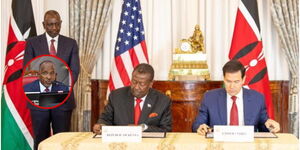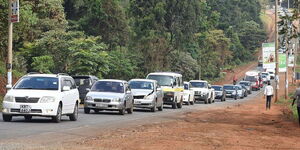Politicians could soon face a major setback if a new Bill before Parliament is enacted, as it seeks to end the long-standing practice of leaders branding public roads with their names, faces, or personal messages after construction or rehabilitation works.
This follows the introduction of the Kenya Roads (Amendment) Bill, 2025, sponsored by Homa Bay Town MP Peter Kaluma, which seeks to outlaw personalised signage on public roads across the country.
The proposed law, currently before the Senate, having been passed by the National Assembly, introduces a new provision making it an offence for any individual to erect or authorise the erection of signs bearing their image, name, or likeness on any public road.
According to the Bill, offenders risk a fine not exceeding Ksh1 million or imprisonment for up to two years, or both, if found putting their images on the projects.
This measure targets governors, members of parliament, and other political leaders who often use public infrastructure projects for political mileage and campaigns, despite the works being fully funded by taxpayers.
“The signage to be erected on any public road shall indicate the classification of the road and the level of government responsible for its management and shall not bear the name, image, or likeness of any person,” reads part of the Bill.
Roads Classification
The Bill also requires that every public road, whether managed by the national or county government, have clear signage showing its classification. This will see Kenyan roads classified into whether they are a national trunk road or a county road, and the agency in charge.
According to the Bill, this provision is meant to improve accountability and make it easier for citizens to know which level of government is responsible for road maintenance.
Kenyan roads are currently managed by key agencies, among them the Kenya National Highways Authority (KeNHA), the Kenya Urban Roads Authority (KURA), and the Kenya Rural Roads Authority (KeRRA).
Roads Structural Changes
Besides the signage rules, the Bill introduces key structural changes in how Kenya’s road network will be managed. It formally introduces the category of county roads, assigning county governments full responsibility for their maintenance, rehabilitation, and development, a function that had largely been handled by national agencies like KeRRA and KURA.
Even so, the Cabinet Secretary for Roads will retain the authority to classify and periodically review all public roads, but the Bill requires such classification to be reviewed at least once every five years to ensure alignment with development needs and population changes.
In addition, the Cabinet Secretary will be mandated to ensure coordination between the national and county governments to avoid duplication and promote uniform standards in road design, maintenance, and signage across the country.
More Powers to Counties
Additionally, counties will also have new powers to manage road reserves, enforce axle-load regulations, enhance road safety, and collect relevant road-use data. This, under the current framework, was largely done by KeNHA.
Road Levy
Over the past year, county governments have been intensely lobbying to have a section of the road levy channelled to their accounts. The Bill seeks an amendment to the Kenya Roads Board Act to change how funds from the Road Maintenance Levy Fund (RMLF) are shared, with five per cent of the fund directly to county governments, ensuring that devolved units receive predictable resources for maintaining county roads.












